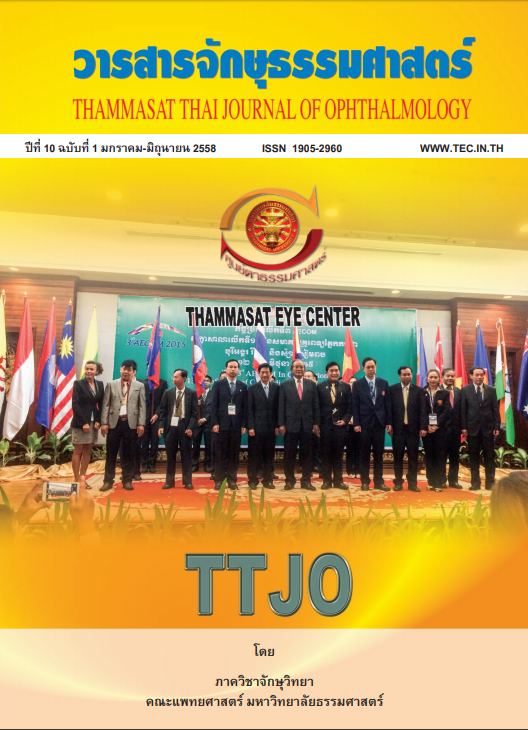การศึกษาประสิทธิผลการตรวจตาบอดสีโดยการใช้แผ่นตรวจตาบอดสี ด้วยตนเอง ชนิด Creamer Chart เปรียบเทียบกับ Standard Ishihara Test
Main Article Content
Abstract
วัตถุประสงค์: เพื่อศึกษาประสิทธิภาพในการใช้ แผ่น ตรวจตาบอดสีด้วยตนเอง ชนิด Creamer Chart เปรียบ เทียบกับ Standard Ishihara Test
รูปแบบการศึกษา: Cross-sectional descriptive study (Diagnostic test)
วิธีการศึกษา: เก็บข้อมูลตาบอดสีชนิดแดงเขียว จากกลุ่มประชากรคือ ประชาชนเพศหญิงและเพศ ชายที่มารับบริการที่แผนกผู้ป่วยนอกที่โรงพยาบาล ธรรมศาสตร์เฉลิมพระเกียรติ โดยเก็บข้อมูลทั้งจากการ ทดสอบด้วยการใช้แผ่นตรวจตาบอดสีชนิด Ishihara Pseudoisochromatic plate ชนิด 24 แผ่น โดยทดสอบ เพียง 17 แผ่นแรก ประเมินผลจากการอ่านตัวเลขผิด จาก 4 ใน 17 ถือว่ามีภาวะตาบอดสี และการตรวจด้วย Creamer Chart แปลผลโดยถ้ามองเห็นเฉพาะวงกลม สีแดง ถือว่ามีภาวะตาบอดสี และนำผลของทั้งสองวิธีมา เปรียบเทียบกัน
ผลการศึกษา: ศึกษากลุ่มประชากรทั้งหมด 1,008 คน เพศชาย 645 คน หญิง 363 คน มีอายุระหว่าง 18 ปี ถึง 88 ปี พบว่ามีภาวะตาบอดสีเขียวแดงจากการตรวจด้วย Ishihara Pseudoisochromatic plate เป็นเพศชาย 53 คน คิดเป็น 8.21% และเพศหญิง 3 คน คิดเป็น 0.82% และ การเก็บข้อมูลโดยใช้ Creamer Chart พบผู้ป่วยตาบอดสี 68 คนในเพศชาย และ 4 คนในเพศหญิง ผลจาก Creamer Chart เทียบ standard test คือ Ishihara คิดเป็น ค่า Sensitivity 83% และ Specificity 95.9% ในเพศชาย และ Sensitivity 100% และ Specificity 99.7% ในเพศ หญิงตามลำดับ
สรุป: พบภาวะตาบอดสีแดงเขียวจากกลุ่มประชากร เพศชาย 8.21% ซึ่งถือว่าเท่ากับการศึกษาอื่นๆ และ 0.82% ในเพศหญิง ซึ่งสูงกว่าการศึกษาอื่นๆ ส่วนการนำCreamer Chart มาใช้ทางคลินิกในการตรวจคัดกรอง ตาบอดสี ยังมีค่า Sensitivity ที่ต่ำเกินไปในเพศชาย อาจ ไม่เหมาะจะนำมาใช้คัดกรองผู้ป่วยตาบอดสีแดงเขียว
Comparative study of effectiveness between Creamer Color Blindness
Quick Test Chart and standard Ishihara Test
Objective: To compare the effectiveness between Creamer Color Blindness Quick Test Chart and Standard Ishihara Test in screening Red-green color deficiency
Design: Cross-sectional descriptive study (Diagnostic test)
Material and Method: Red-green color deficiency was tested from the male volunteer at Thammasat University Hospital Eye center by using standard Ishihara Pseudoisochromatic plate (24 plate), using the first 17 plate to interpret result, positive result define as 4 or more in 17 plate that volunteer cannot read correctly, and using Creamer Chart that interpret positive result by volunteer can see only the circle but cannot see the star, then compare the results between two method and analyze the sensitivity and specificity of Creamer Chart using standard Ishihara Pseudoisochromatic plate as standard test
Results: Total 1,008 volunteer was studied, male 645 female 363 age group between 18-88 years, in male Red-green deficiency found 53 positive results from standard Ishihara Pseudoisochromatic plate (8.21%), and 68 positive results found from Creamer Chart, in female Red-green deficiency found 3 positive results from standard Ishihara Pseudoisochromatic plate (0.82%), and 4 positive results found from Creamer Chart, 83% sensitivity and 95.9% specificity in male and 100% sensitivity and 99.7% specificity in female of Creamer Chart by using standard Ishihara Pseudoisochromatic plate as standard test was calculated
Conclusion: Prevalence of Red-green color deficiency in male volunteer in this study is 8.21%, that was the same as other study, but in female is 0.82% that higher than other study, it may be caused by nonrandomize sampling, so it cannot be generalized to larger populations, and the Clinical use of Creamer Chart in screening Red-green color deficiency was limited by its lower in sensitivity


